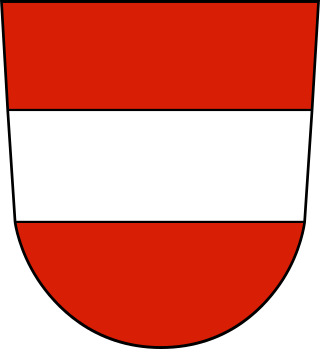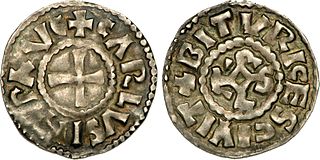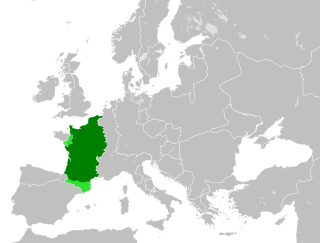
Charles Martel was a Frankish political and military leader who, as Duke and Prince of the Franks and Mayor of the Palace, was the de facto ruler of the Franks from 718 until his death. He was a son of the Frankish statesman Pepin of Herstal and a noblewoman named Alpaida. Charles, also known as "The Hammer", successfully asserted his claims to power as successor to his father as the power behind the throne in Frankish politics. Continuing and building on his father's work, he restored centralized government in Francia and began the series of military campaigns that re-established the Franks as the undisputed masters of all Gaul. According to a near-contemporary source, the Liber Historiae Francorum, Charles was "a warrior who was uncommonly ... effective in battle".

The House of Babenberg was a noble dynasty of Austrian Dukes and Margraves. Originally from Bamberg in the Duchy of Franconia, the Babenbergs ruled the imperial Margraviate of Austria from its creation in 976 AD until its elevation to a duchy in 1156, and from then until the extinction of the line in 1246, whereafter they were succeeded by the House of Habsburg, to which they were related.

Pepin II, commonly known as Pepin of Herstal, was a Frankish statesman and military leader who de facto ruled Francia as the Mayor of the Palace from 680 until his death. He took the title Duke and Prince of the Franks upon his conquest of all the Frankish realms.

Hugh Capet was the King of the Franks from 987 to 996. He is the founder of and first king from the House of Capet. The son of the powerful duke Hugh the Great and his wife Hedwige of Saxony, he was elected as the successor of the last Carolingian king, Louis V. Hugh was descended from Charlemagne's son Pepin of Italy through his mother and paternal grandmother, respectively, and was also a nephew of Otto the Great.

Carloman was the eldest son of Charles Martel, mayor of the palace and duke of the Franks, and his wife Chrotrud of Treves. On Charles's death (741), Carloman and his brother Pepin the Younger succeeded to their father's legal positions, Carloman in Austrasia, and Pepin in Neustria. He was a member of the family later called the Carolingians and it can be argued that he was instrumental in consolidating their power at the expense of the ruling Merovingian kings of the Franks. He withdrew from public life in 747 to take up the monastic habit, "the first of a new type of saintly king", according to Norman Cantor, "more interested in religious devotion than royal power, who frequently appeared in the following three centuries and who was an indication of the growing impact of Christian piety on Germanic society".

Charles III, called the Simple or the Straightforward, was the king of West Francia from 898 until 922 and the king of Lotharingia from 911 until 919–923. He was a member of the Carolingian dynasty.

Neustria was the western part of the Kingdom of the Franks during the early middle ages, in contrast to the eastern Frankish kingdom, Austrasia. It initially included land between the Loire and the Silva Carbonaria, in the north of present-day France, with Paris, Orléans, Tours, Soissons as its main cities. The population was therefore originally largely Romanised.

The Carolingian dynasty was a Frankish noble family named after Charlemagne, grandson of mayor Charles Martel and a descendant of the Arnulfing and Pippinid clans of the 7th century AD. The dynasty consolidated its power in the 8th century, eventually making the offices of mayor of the palace and dux et princeps Francorum hereditary, and becoming the de facto rulers of the Franks as the real powers behind the Merovingian throne. In 751 the Merovingian dynasty which had ruled the Germanic Franks was overthrown with the consent of the Papacy and the aristocracy, and Pepin the Short, son of Martel, was crowned King of the Franks. The Carolingian dynasty reached its peak in 800 with the crowning of Charlemagne as the first Emperor of the Romans in the West in over three centuries. His death in 814 began an extended period of fragmentation of the Carolingian Empire and decline that would eventually lead to the evolution of the Kingdom of France and the Holy Roman Empire.

Robert I was the elected King of West Francia from 922 to 923. Before his election to the throne he was Count of Poitiers, Count of Paris and Marquis of Neustria and Orléans. He succeeded the overthrown Carolingian king Charles the Simple, who in 898 had succeeded Robert's brother, king Odo.

The Kingdom of the Franks, also known as the Frankish Kingdom, the Frankish Empire or Francia, was the largest post-Roman barbarian kingdom in Western Europe. It was ruled by the Frankish Merovingian and Carolingian dynasties during the Early Middle Ages. Francia was among the last surviving Germanic kingdoms from the Migration Period era.

East Francia or the Kingdom of the East Franks was a successor state of Charlemagne's empire ruled by the Carolingian dynasty until 911. It was created through the Treaty of Verdun (843) which divided the former empire into three kingdoms.

Pepin the Short, was King of the Franks from 751 until his death in 768. He was the first Carolingian to become king.

In medieval history, West Francia or the Kingdom of the West Franks refers to the western part of the Frankish Empire established by Charlemagne. It was the forerunner of the future Kingdom of France and existed from 843 to 987. West Francia emerged from the partition of the Carolingian Empire in 843 under the Treaty of Verdun following the death of Charlemagne's son, Louis the Pious.

The Duchy of Franconia was one of the five stem duchies of East Francia and the medieval Kingdom of Germany emerging in the early 10th century. The word Franconia, first used in a Latin charter of 1053, was applied like the words Francia, France, and Franken, to a portion of the land occupied by the Franks.
Henry was the leading military commander of the last years of the Carolingian Empire. He was commander-in-chief under Kings Louis the Younger and Charles the Fat. His early career was mostly restricted to East Francia, his homeland, but after Charles inherited West Francia in 884 he was increasingly active there. During his time, raids by the Vikings peaked in Francia. The sources describe at least eight separate campaigns waged by Henry against the Vikings, most of them successful.
The Robertians are the proposed Frankish family which was ancestral to the Capetian dynasty, and thus to the royal families of France and of many other countries. The Capetians appear first in the records as powerful nobles serving under the Carolingian dynasty of Charlemagne in West Francia, which later became France. As their power increased, they came into conflict with the older royal family and attained the crown several times before the eventual start of the continuous rule of the descendants of Hugh Capet.
The Duchy of Alsace was a large political subdivision of the Frankish Empire during the last century and a half of Merovingian rule. It corresponded to the territory of Alsace and was carved out of southern Austrasia in the last decade of the reign of Dagobert I, probably to stabilise the southern reaches of Austrasia against Alemannia and Burgundy. By the late Middle Ages, the region was considered part of Swabia.
Drogo was a Frankish nobleman of the Pippinid family and the eldest son of Carloman, mayor of the palace of Austrasia under the Merovingian king Childeric III. He succeeded to his father's office in 747, but was soon squeezed out of power by his uncle, Pippin III, the mayor in Neustria. He resisted his uncle's takeover, but in 753 was captured and forced to become a monk.

Louis IV, called d'Outremer or Transmarinus, reigned as King of West Francia from 936 to 954. A member of the Carolingian dynasty, he was the only son of king Charles the Simple and his second wife Eadgifu of Wessex, daughter of King Edward the Elder of Wessex. His reign is mostly known thanks to the Annals of Flodoard and the later Historiae of Richerus.